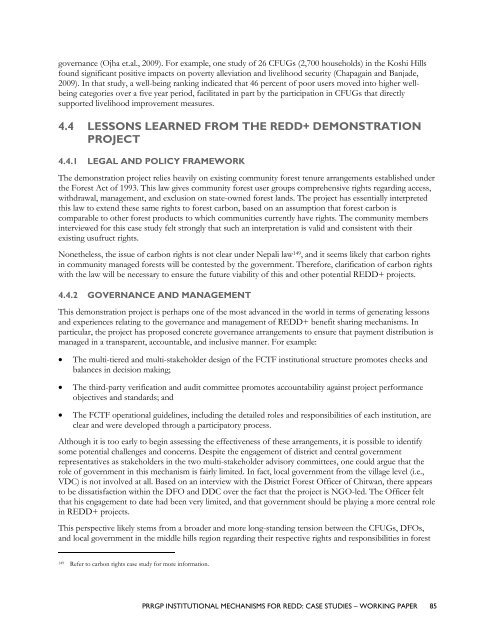Institutional Mechanisms for REDD+ - Case Studies Working Paper
Institutional Mechanisms for REDD+ - Case Studies Working Paper
Institutional Mechanisms for REDD+ - Case Studies Working Paper
You also want an ePaper? Increase the reach of your titles
YUMPU automatically turns print PDFs into web optimized ePapers that Google loves.
governance (Ojha et.al., 2009). For example, one study of 26 CFUGs (2,700 households) in the Koshi Hills<br />
found significant positive impacts on poverty alleviation and livelihood security (Chapagain and Banjade,<br />
2009). In that study, a well-being ranking indicated that 46 percent of poor users moved into higher wellbeing<br />
categories over a five year period, facilitated in part by the participation in CFUGs that directly<br />
supported livelihood improvement measures.<br />
4.4 LESSONS LEARNED FROM THE <strong>REDD+</strong> DEMONSTRATION<br />
PROJECT<br />
4.4.1 LEGAL AND POLICY FRAMEWORK<br />
The demonstration project relies heavily on existing community <strong>for</strong>est tenure arrangements established under<br />
the Forest Act of 1993. This law gives community <strong>for</strong>est user groups comprehensive rights regarding access,<br />
withdrawal, management, and exclusion on state-owned <strong>for</strong>est lands. The project has essentially interpreted<br />
this law to extend these same rights to <strong>for</strong>est carbon, based on an assumption that <strong>for</strong>est carbon is<br />
comparable to other <strong>for</strong>est products to which communities currently have rights. The community members<br />
interviewed <strong>for</strong> this case study felt strongly that such an interpretation is valid and consistent with their<br />
existing usufruct rights.<br />
Nonetheless, the issue of carbon rights is not clear under Nepali law 149, and it seems likely that carbon rights<br />
in community managed <strong>for</strong>ests will be contested by the government. There<strong>for</strong>e, clarification of carbon rights<br />
with the law will be necessary to ensure the future viability of this and other potential <strong>REDD+</strong> projects.<br />
4.4.2 GOVERNANCE AND MANAGEMENT<br />
This demonstration project is perhaps one of the most advanced in the world in terms of generating lessons<br />
and experiences relating to the governance and management of <strong>REDD+</strong> benefit sharing mechanisms. In<br />
particular, the project has proposed concrete governance arrangements to ensure that payment distribution is<br />
managed in a transparent, accountable, and inclusive manner. For example:<br />
� The multi-tiered and multi-stakeholder design of the FCTF institutional structure promotes checks and<br />
balances in decision making;<br />
� The third-party verification and audit committee promotes accountability against project per<strong>for</strong>mance<br />
objectives and standards; and<br />
� The FCTF operational guidelines, including the detailed roles and responsibilities of each institution, are<br />
clear and were developed through a participatory process.<br />
Although it is too early to begin assessing the effectiveness of these arrangements, it is possible to identify<br />
some potential challenges and concerns. Despite the engagement of district and central government<br />
representatives as stakeholders in the two multi-stakeholder advisory committees, one could argue that the<br />
role of government in this mechanism is fairly limited. In fact, local government from the village level (i.e.,<br />
VDC) is not involved at all. Based on an interview with the District Forest Officer of Chitwan, there appears<br />
to be dissatisfaction within the DFO and DDC over the fact that the project is NGO-led. The Officer felt<br />
that his engagement to date had been very limited, and that government should be playing a more central role<br />
in <strong>REDD+</strong> projects.<br />
This perspective likely stems from a broader and more long-standing tension between the CFUGs, DFOs,<br />
and local government in the middle hills region regarding their respective rights and responsibilities in <strong>for</strong>est<br />
149 Refer to carbon rights case study <strong>for</strong> more in<strong>for</strong>mation.<br />
PRRGP INSTITUTIONAL MECHANISMS FOR REDD: CASE STUDIES – WORKING PAPER 85

















